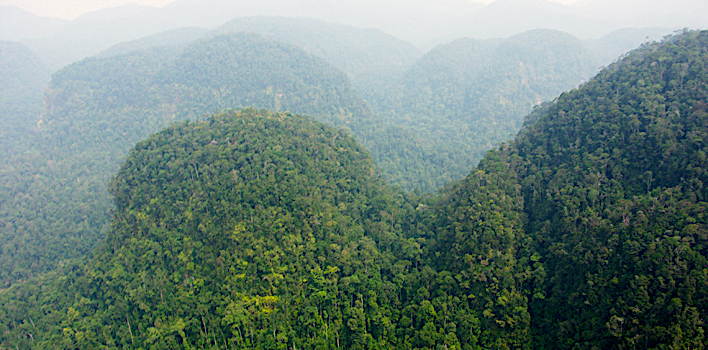Dirty Tricks Behind Conservation U-turn for World’s Rarest Ape
Scientists and conservation organizations are deeply concerned after an ally in an ongoing campaign to halt a destructive hydropower project in Sumatra, Indonesia, has flipped their position and announced a partnership with the company behind the dam.
Swiss-based PanEco Foundation, which manages the Sumatran Orangutan Conservation Programme, has for several years been a fierce opponent of the hydro-dam project, which is under construction in the core habitat of the Tapanuli orangutan—the world’s rarest species of Great Ape.
Enormous Loss of Credibility for PanEco
Fewer than 800 of the apes survive today, living only in the Batang Toru ecosystem in north Sumatra—an area just a tenth the size of Sydney, Australia. And the new hydro-project is being built in the ape’s most critical habitat, which has by far the highest density of orangutans (according to the company’s own Environmental Impact Statement).
As a result, the hydro-project has been stridently denounced by scientists and conservationists in Indonesia and globally as a disaster for the Tapanuli orangutan.
Fragmentation and Extinction
One of the many negative impacts of the project will be permanent fragmentation of the apes and their ecosystem, making it all but inevitable that isolated subpopulations will be condemned to functional or actual extinction. Around a quarter of the surviving population would be trapped by the hydro scheme, drastically reducing its survival chances as well as for the overall population of the Tapanuli orangutan species.
PanEco announced a partnership with the Indonesian hydro company, PT North Sumatra Hydro Energy, on August 23. At that time, their website stated “A newly planned hydro-electric dam along the Batang Toru River is the greatest threat to the long-term future of the Tapanuli orangutan.”
PanEco further said, “The constructiuon of the hydrodam and related infrastructure, powerlines, and associated land speculation will cause severe fragmentation of the rainforest and isolation of sub-populations of the Tapanuli orangutan, making them prone to extinction.”
But astonishingly, by August 28, the dam had been fully removed from the list of threats to the Batang Toru ecosystem on PanEco’s website—a stunning about-face.
Beyond speaking out against the hydro-project via their website, social media, and press releases, PanEco staff have been key authors of peer-reviewed scientific papers that cite the hydro-project as a dire threat to the Tapanuli orangutan.
Now, PanEco is painting the hydro-project as the species’ greatest hope, rather than its greatest threat—leaving scientists and conservationists around the world feeling utterly mystified and betrayed.
What Happened?
It is thought that the abrupt U-turn by the Board of the PanEco Foundation has been caused by a series of underhanded tactics by the hydro-dam company, including threatening law suits against its Sumatra-based staff, and proposals to deport PanEco and other visiting scientists who have spoken out publicly against the dam.
In open letters delivered to Indonesian President Joko Widodo, ALERT members and other leading scientists have previously decried a wide range of illicit and even illegal tactics being used by the Indonesian dam company to help silence its critics.
Notably, a senior member of PanEco staff implored his colleagues, just a few days before the partnership announcement, to stay quiet about the issue as he feared it would have “serious consequences for me personally”.
Scary Precedent
The announcement of the broken partnership between PanEco and other scientific and conservation groups sets an extremely worrying precedent for silencing opposing voices in development and conservation debates, and is a classic case of aggressive greenwashing.
PanEco’s public justification for the move appears to be based on the assumption that the campaign to halt the dam project is futile—a position not shared by many other authorities and conservationists.
Worse, PanEco’s partnership may make the dam a self-fulfilling prophecy, as its endorsement is likely to be used by the dam company to try to secure funding for the dam.
Financing from the Bank of China is looking tenuous thanks to intense dialogue between nongovernmental groups, scientists, and the Bank to put the project’s many environmental, social, and reputational risks under the spotlight.
Despite PanEco giving in to the bullying tactics of the dam company, a broad coalition of Indonesian and international scientists and conservationists continues to sound the alarm about the Batang Toru dam.
A Cry for the Tapanuli Orangutan
We are calling on the Indonesian government to robustly evaluate the impact of the project on the Tapanuli orangutan and other protected species, before any further developments take place, as is required under Indonesian environmental laws.
Websites like PanEco’s can be altered, but the facts and the science haven’t changed: this dam project remains a massive threat to the survival of the Tapanuli orangutan. Halting the project’s development remains an absolute priority to secure a safe future for the species.
The hydro-project would generate only a modest energy supply (510 mega-watts), which could easily be generated via expansion of the nearby Sarulla Geothermal Plant.
This is not a question of development versus conservation. North Sumatra can have both increased electricity and a future for the Tapanuli orangutan—but only if the Batang Toru Dam is halted before it is too late.




